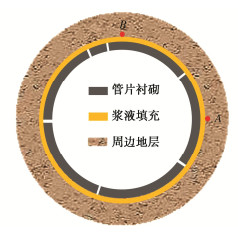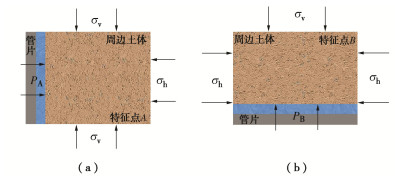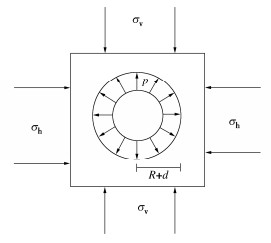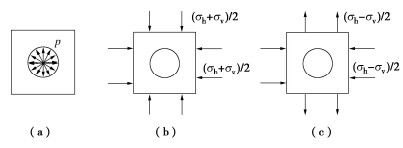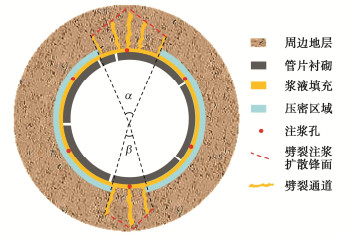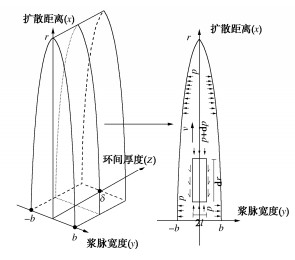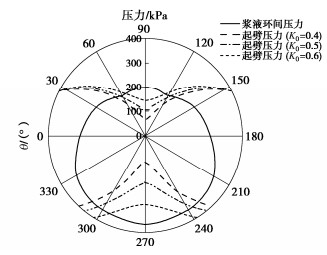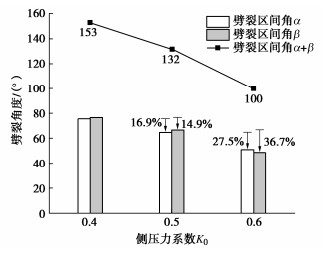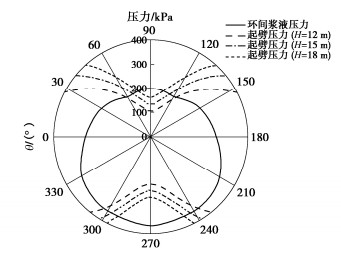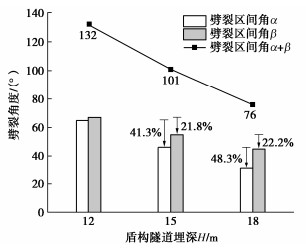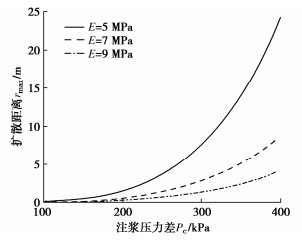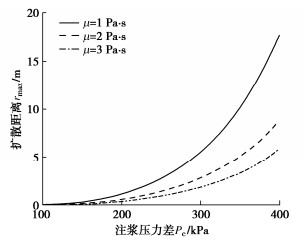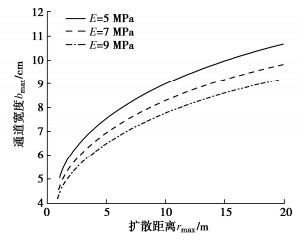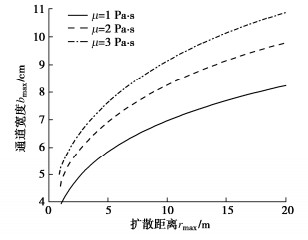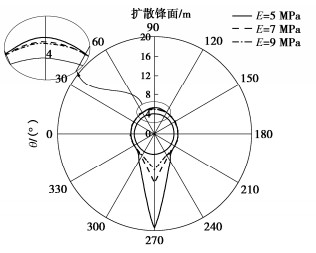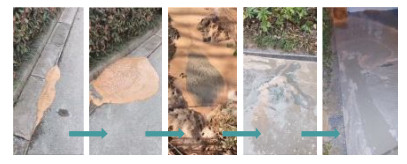Compaction-fracture diffusion model for backfill grouting of shield tunnels in low permeability strata
-
摘要: 通过对盾构隧道环向浆液压力分布、起劈压力分布的计算,建立了低渗地层盾构隧道壁后注浆压密-劈裂扩散模型,提出了环向劈裂区间角及其计算方法,给出了浆液扩散距离与劈裂通道宽度计算式,并分析土体侧压力系数、盾构埋深对劈裂区间角的影响及土体弹性模量、浆液黏度对浆液最大扩散距离与劈裂通道宽度的影响,结合理论对盾构掘进过程中地表冒浆问题进行了讨论。研究结果表明:在低渗地层进行盾构隧道壁后注浆时,浆液在劈裂区间角内以劈裂形式扩散,在其余区域以压密形式扩散;劈裂区间角与土体侧压力系数、隧道埋深均呈负相关关系;最大扩散距离与注浆压力差,最大通道宽度与最大扩散距离均呈指数关系,其指数分别为4,0.25;正常注浆参数下,浆液向下扩散距离远大于向上扩散距离,结合某城际铁路盾构隧道实际注浆参数及地层参数,分析了地表冒浆的原因,进一步验证了该扩散模型的合理性。Abstract: Based on the calculation of annular grout pressure distribution and fracturing pressure distribution of shield tunnels, the grouting compaction-fracture diffusion model for shield tunnel segments in low permeability strata is established, the annular fracturing interval angle and its calculation method are proposed, and the formula for calculating the diffusion distance and channel width is given. The influences of lateral pressure coefficient of soils and buried depth of shield on the fracturing interval angle as well as those of elastic modulus of soils and grout viscosity on the maximum diffusion distance and channel width are analyzed. The results show that the grout diffuses in fracture mode in the fracture interval angle, and the grout diffuses in compaction mode in the other regions. The fracturing interval angle is negatively correlated with lateral pressure coefficient of soils and tunnel depth. The relationship between the maximum diffusion distance and the grouting pressure difference and that between the maximum channel width and the maximum diffusion distance are both exponential, and the indices are 4 and 0.25, respectively. Under the normal grouting parameters, the downward diffusion distance of the diffusion grout is much larger than the upward one. Based on the actual grouting parameters and stratum parameters of an inter-city railway shield tunnel, the causes for surface grout-oozing are analyzed, and the rationality of diffusion model is further verified.
-
Keywords:
- shield tunnel /
- backfill grouting /
- fracture diffusion /
- diffusion distance
-
0. 引言
各向异性是黏土的基本性质之一,分为原生各向异性和次生各向异性。针对原生各向异性对黏土力学性状的影响,许多学者对与沉积平面呈不同夹角试样进行压缩、无侧限压缩和三轴压缩等试验,发现原生各向异性对黏土变形以及强度特性的影响不容忽视。
小应变剪切模量特性作为土的重要力学性质之一,也同样受到原生各向异性的影响。Simpson等[1]的研究表明,小应变剪切模量的原生各向异性对隧道及基坑周围土体变形的预测结果影响很大;Jovičić等[2]和吴宏伟等[3]分别针对伦敦黏土和上海软黏土进行研究,利用弯曲元测得两种土在低围压下水平和竖直方向上的最大剪切模量比值分别为1.5和1.21,说明对于不同种类黏土,原生各向异性对其小应变剪切模量的影响不尽相同。
结构性黏土在我国东南沿海地区分布广泛,许多工程建设涉及到此类黏土,迄今已对其小应变剪切模量进行了诸多研究,但以往的研究主要考虑孔隙比、应力水平和结构损伤等对小应变剪切模量的影响[4],而考虑原生各向异性对小应变剪切模量影响的研究较少,有必要进行系统探究。
本文对不同削样方向的湛江黏土原状试样开展不同围压下的共振柱试验,研究原生各向异性对最大动剪切模量的影响以及考虑原生各向异性的最大动剪切模量随围压演化规律的表征方法。
1. 试验材料与试验方案
1.1 试验材料与试样制备
土样取自湛江市某基坑内地下10~11 m,尺寸为30 cm×30 cm×30 cm原状块状样。表1为其基本物理力学指标与颗粒组成。由表1可见,湛江黏土具有较差物理性质,与软黏土相似,但力学性质较优,呈现上述特性的原因为其具有的强结构性[4]。
表 1 湛江黏土平均物理力学性质指标与颗粒组成Table 1. Physical and mechanical indexes and particle composition of Zhanjiang clay重度γ/(kN·m-3) 含水率w/% 孔隙比e 渗透系数K/(cm·s-1) 液限wL/% 塑限wP/% 塑性指数IP 结构屈服应力σk/kPa 无侧限抗压强度/kPa 灵敏度St 颗粒组成/% >0.05/mm 0.005~0.05/mm 0.002~0.005/mm <0.002/mm 17.1 52.98 1.44 2.73×10−8 59.6 28.1 31.5 400 143.5 7.2 8.2 39.5 20.7 31.6 图1(a)为不同方向圆柱试样示意图,定义试样轴线与土体沉积平面夹角为
α ,即竖直方向试样为90°,水平方向试样为0°。针对α 为0°,22.5°,45°,67.5°,90°方向原状样进行研究,试样规格尺寸为直径50 mm,高度100 mm的圆柱体。1.2 试验方法
试验所用设备为GDS共振柱仪,如图1(b)所示。试样的边界条件为一端固定,一端自由。通过电磁驱动系统对试样逐级施加扭矩,测得试样的共振频率和对应的剪应变,试样动剪切模量由下式得到:
G=ρ(2πfH/β)2, (1) 式中,G为试样动剪切模量,ρ为试样密度,f为共振频率,H为试样高度,β为扭转振动频率方程特征值。
试样在抽气饱和后安装至共振柱仪上,随后进行反压饱和,当B值达0.98后,进行固结,围压分别设定为50,100,200,300,400,500,600,700,800 kPa。试样固结完成后,进行共振柱试验。
2. 试验结果与分析
2.1 不同方向试样G-
γ 曲线规律如图2所示,不同方向试样动剪切模量G和剪应变
γ 的关系曲线形态与规律类似。剪切模量在小剪应变下衰减速度较小;随剪应变发展,衰减速度增大。低围压下G-γ 曲线随围压增大而上移,围压超过600~700 kPa,G-γ 曲线随围压增长而下移,与通常软黏土G-γ 曲线大多随围压增大而单调上移规律存在明显差异,说明结构性对湛江黏土G-γ 曲线规律影响较大。2.2 原生各向异性对最大动剪切模量的影响
湛江黏土动应力-应变关系可用Hardin-Drnevich双曲线模型表征,如下式:
τ=γa+bγ, (2) 式中,a,b为拟合参数。式(2)可以写为
1/G=a+bγ。 (3) 式(3)中,当
γ 趋近于0时,得到最大动剪切模量Gmax=1/a,利用式(3)求得不同方向试样在各围压下的Gmax。为了消除孔隙比对Gmax的影响,引入孔隙比函数F(e)=1/(0.3+0.7e2)将Gmax进行归一化处理,图3为经孔隙比函数归一化的Gmax/F(e)-围压σ3 曲线。随围压增大,不同方向试样Gmax/F(e)-σ3 曲线均呈现先上升后下降的规律,在围压为400~500 kPa即在σk 左右时,曲线出现转折。为了更好描述原生各向异性对最大动剪切模量的影响,定义Gmax/F(e)的原生各向异性系数:
Kα=Dα/D90°, (4) 式中,Dα定义为α方向试样的Gmax/F(e),D90°定义为90°(竖直)方向试样的Gmax/F(e)。
Gmax/F(e)的原生各向异性系数Kα与围压的关系如图4所示。相同围压下,Kα随方向角
α 变化,Kα整体上随α 增大而减小,即试样的方向越靠近水平其刚度越大,说明原生各向异性对湛江黏土最大动剪切模量Gmax的影响十分显著。湛江黏土基本单元为扁平状片堆、粒状碎屑矿物与单片颗粒,上述基本单元在沉积时,其长轴更倾向于水平方向,导致颗粒间水平方向的接触更紧密,结构更强[3],进而更靠近水平方向试样的刚度更大。当围压低于400~600 kPa时,同一方向试样Kα随围压增长基本保持恒定,K0°,K22.5°,K45°,K67.5°,K90°分别为1.314,1.279,1.148,1.045,1;当围压高于400~600 kPa时,同一方向试样Kα随围压增长呈明显减小趋势,不同方向试样的Gmax/F(e)差异减小。说明围压低于
σk 时,围压的增大几乎不影响原生各向异性对Gmax的影响,但当围压超过σk 后,围压的增大减弱了原生各向异性对Gmax的影响。文献[2]中伦敦黏土在围压超过屈服应力后,其水平与竖直方向试样的最大剪切模量的差异随围压增长也呈减小趋势,与本文试验结果一致。2.3 考虑原生各向异性的最大动剪切模量表征方法
图3中出现Gmax/F(e)随围压增大呈先上升后下降的特殊现象,文献[4]认为Gmax同时受到平均有效应力、孔隙比和结构损伤的影响,采用该文的表征方法对试验结果进行分析,具体的表达形式如下所示:
Gmax/F(e)=A(1+(σ′mpa)n)1+B(1+(σ′mpa)n)(kr+1−kr1+(ησ′mpc)λ)。 (5) 式中 A,B,n,kr,η和
λ 为反映各种应力历史和土体性质的参数;σ′m 为围压;pa为标准大气压;pc为表观前期固结压力即结构屈服应力σk ,不同方向试样压缩试验得到的σk 差异较小,均取400 kPa。采用式(5)将不同方向试样Gmax/F(e)与围压的关系进行定量表征。从图4可得,高应力下各向异性对试样的Gmax/F(e)影响减弱,可假定不同方向试样Gmax/F(e)极限值相同。最终将试验数据与拟合曲线一同绘制于图5,发现拟合效果很好,拟合参数见表2。
表 2 不同方向试样拟合参数Table 2. Fitting parameters of specimens in different directionsα A/MPa B n kr η λ R2 0° 39.92489 0.16678 0.54309 0.35092 0.56433 6.42998 0.99251 22.5° 37.89951 0.15999 0.58264 0.35462 0.56426 6.37147 0.99075 45° 33.76328 0.15168 0.54642 0.37740 0.55402 6.38473 0.99432 67.5° 31.15476 0.15761 0.56254 0.42499 0.60889 6.07737 0.99727 90° 29.75422 0.15743 0.56067 0.44448 0.57750 6.05669 0.99835 分析表2中拟合参数与试样方向的关系,可得参数A,kr,
λ 和试样轴线与土体沉积平面夹角α 呈线性关系(图6),参数B,n,η随α 增大分别保持在0.1587,0.5591,0.5738上下,且波动范围较小(参数B,n,η的标准差S分别为0.005455,0.01570和0.02131)。将图6中参数A,kr,
λ 的拟合方程和参数B,n,η的平均值同时代入式(5),得到考虑原生各向异性的最大动剪切模量的表征方法:Gmax/F(e)=(c1α+c2)(1+(σ′mpa)n)1+B(1+(σ′mpa)n)· ((d1α+d2)+1−(d1α+d2)1+(ησ′mpc)(e1α+e2))。 (6) 式中
σ′m 为围压;α 表示试样的方向,为试样轴线与土体沉积平面夹角;pa为标准大气压,取101.325 kPa;pc为σk ,取400 kPa;B=0.1587,n=0.5591,η=0.5738;c1=−0.1204,c2=39.9166;d1=1.144×10−3,d2=0.3390;e1=−4.625×10−3,e2=6.4722。3. 结论
(1)在同一围压下,不同
α 试样经孔隙比函数归一化的最大动剪切模量Gmax/F(e)与90°方向试样Gmax/F(e)的比值Kα随α 增大而减小。当围压低于和高于σk 时,同一α 试样Kα随围压增长分别呈基本保持恒定与明显减小趋势,说明当围压低于σk 时,围压几乎不影响原生各向异性对Gmax影响,围压超过σk 后,不同方向的Gmax/F(e)差异减小,围压的增大减弱了原生各向异性对Gmax的影响。(2)受固结压硬和结构损伤的影响,湛江黏土的Gmax/F(e)变化规律与通常软黏土试验结果不同,不同方向试样的Gmax/F(e)随围压增大均呈先增大后减小规律,当围压在
σk 左右时出现转折。(3)基于采用考虑结构损伤的公式可很好拟合湛江黏土不同方向试样Gmax与围压关系曲线,提出了考虑原生各向异性影响的Gmax演化规律表征方法。
-
表 1 盾构隧道参数
Table 1 Parameters of shield tunnel
管片外半径/m 盾尾间隙厚度/m 隧道埋深/m 4.725 0.16 12 表 2 同步注浆注浆孔布置参数
Table 2 Parameters for layout of synchronous grouting holes
参数 注浆孔序号 1 2 3 4 5 6 位置/(°) 35 90 145 215 270 325 注浆压力/kPa 230 200 230 340 370 340 表 3 其他计算参数
Table 3 Other parameters
浆液密度/(kg·m-3) 浆液黏度/(Pa·s) 环厚δ/m 2190 2 0.0216 截面流量/(m3·s-1) 土体抗拉强度/
kPa侧压力系数 4.3453×10-4 40 0.5 -
[1] 何川, 封坤, 方勇. 盾构法修建地铁隧道的技术现状与展望[J]. 西南交通大学学报, 2015, 50(1): 97-109. doi: 10.3969/j.issn.0258-2724.2015.01.015 HE Chuan, FENG Kun, FANG Yong. Review and prospects on constructing technologies of metro tunnels using shield tunnelling method[J]. Journal of Southwest Jiaotong University, 2015, 50(1): 97-109. (in Chinese) doi: 10.3969/j.issn.0258-2724.2015.01.015
[2] 交通运输部. 2023年8月城市轨道交通运营数据速报[EB/OL]. [2023-09-09]. https://www.mot.gov.cn/fenxigongbao/yunlifenxi/202309/t20230905_3908942.html. Ministry of Transport of the People's Republic of China. Urban rail transit operation data report in August[EB/OL]. [2023-09-09]. https://www.mot.gov.cn/fenxigongbao/yunlifenxi/202309/t20230905_3908942.html. (in Chinese
[3] 张凤祥. 盾构隧道[M]. 北京: 人民交通出版社, 2004. ZHANG Fengxiang. Shield Tunnelling Method[M]. Beijing: China Communications Press, 2004. (in Chinese)
[4] LOGANATHAN N. Analytical prediction for tunneling- induced ground movements in clays[J]. Journal of Geotechnical and Geoenvironmental Engineering, 1998, 124(9): 846-856. doi: 10.1061/(ASCE)1090-0241(1998)124:9(846)
[5] LEE K M, ROWE R K, LO K Y. Subsidence owing to tunnelling Ⅰ: estimating the gap parameter[J]. Canadian Geotechnical Journal, 1992, 29(6): 929-940. doi: 10.1139/t92-104
[6] SHIRLAW J N, RICHARDS D P, Ramond P, et al. Recent experience in automatic tail void grouting with soft ground tunnel boring machines[C]// Proceedings of the ITA-AITES World Tunnel Congress. Singapore, 2004: 22-27.
[7] 叶飞. 软土盾构隧道施工期上浮机理分析及控制研究[D]. 上海: 同济大学, 2007. YE Fei. Analysis and Control for Upward Movement of Shield Tunnel During Construction[D]. Shanghai: Tongji University, 2007. (in Chinese)
[8] 李培楠, 石来, 李晓军, 等. 盾构隧道同步注浆纵环向整体扩散理论模型[J]. 同济大学学报(自然科学版), 2020, 48(5): 629-637. https://www.cnki.com.cn/Article/CJFDTOTAL-TJDZ202005001.htm LI Peinan, SHI Lai, LI Xiaojun, et al. Theoretical model of synchronous grouting longitudinal- circumferential integrated diffusion of shield tunnels[J]. Journal of Tongji University (Natural Science), 2020, 48(5): 629-637. (in Chinese) https://www.cnki.com.cn/Article/CJFDTOTAL-TJDZ202005001.htm
[9] 梁禹, 阳军生, 王树英, 等. 考虑时变性影响的盾构壁后注浆浆液固结及消散机制研究[J]. 岩土力学, 2015, 36(12): 3373-3380. doi: 10.16285/j.rsm.2015.12.005 LIANG Yu, YANG Junsheng, WANG Shuying, et al. A study on grout consolidation and dissipation mechanism during shield backfilled grouting with considering time effect[J]. Rock and Soil Mechanics, 2015, 36(12): 3373-3380. (in Chinese) doi: 10.16285/j.rsm.2015.12.005
[10] 杨琪, 耿萍, 唐睿, 等. 非饱和地层中盾构隧道壁后注浆浆液渗透扩散机理[J]. 中国铁道科学, 2020, 41(6): 100-108. https://www.cnki.com.cn/Article/CJFDTOTAL-ZGTK202006011.htm YANG Qi, GENG Ping, TANG Rui, et al. Slurry seepage and diffusion mechanism of shield tunnel backfilling grouting in unsaturated stratum[J]. China Railway Science, 2020, 41(6): 100-108. (in Chinese) https://www.cnki.com.cn/Article/CJFDTOTAL-ZGTK202006011.htm
[11] 叶飞, 苟长飞, 陈治, 等. 盾构隧道黏度时变性浆液壁后注浆渗透扩散模型[J]. 中国公路学报, 2013, 26(1): 127-134. doi: 10.3969/j.issn.1001-7372.2013.01.018 YE Fei, GOU Changfei, CHEN Zhi, et al. Back-filled grouts diffusion model of shield tunnel considering its viscosity degeneration[J]. China Journal of Highway and Transport, 2013, 26(1): 127-134. (in Chinese) doi: 10.3969/j.issn.1001-7372.2013.01.018
[12] 叶飞, 陈治, 苟长飞, 等. 基于球孔扩张的盾构隧道壁后注浆压密模型[J]. 交通运输工程学报, 2014, 14(1): 35-42. https://www.cnki.com.cn/Article/CJFDTOTAL-JYGC201401008.htm YE Fei, CHEN Zhi, GOU Changfei, et al. Grouting compaction model behind shield tunnel wall based on spherical hole expansion[J]. Journal of Traffic and Transportation Engineering, 2014, 14(1): 35-42. (in Chinese) https://www.cnki.com.cn/Article/CJFDTOTAL-JYGC201401008.htm
[13] 白云, 戴志仁, 张莎莎, 等. 盾构隧道同步注浆浆液压力扩散模式研究[J]. 中国铁道科学, 2011, 32(4): 38-45. https://www.cnki.com.cn/Article/CJFDTOTAL-ZGTK201104009.htm BAI Yun, DAI Zhiren, ZHANG Shasha, et al. Study on the grout pressure dissipation mode in simultaneous backfill grouting during shield tunneling[J]. China Railway Science, 2011, 32(4): 38-45. (in Chinese) https://www.cnki.com.cn/Article/CJFDTOTAL-ZGTK201104009.htm
[14] 毛家骅. 基于渗滤效应的盾构隧道壁后注浆浆液扩散机理研究[D]. 西安: 长安大学, 2016. MAO Jiahua. Study on the Grouts Diffusion Mechanism of Shield Tunnel Back-Filled Grouts Based on Filtration[D]. Xi'an: Changan University, 2016. (in Chinese)
[15] 叶飞, 王斌, 韩鑫, 等. 盾构隧道壁后注浆试验与浆液扩散机理研究进展[J]. 中国公路学报, 2020, 33(12): 92-104. https://www.cnki.com.cn/Article/CJFDTOTAL-ZGGL202012008.htm YE Fei, WANG Bin, HAN Xin, et al. Review of shield tunnel backfill grouting tests and its diffusion mechanism[J]. China Journal of Highway and Transport, 2020, 33(12): 92-104. (in Chinese) https://www.cnki.com.cn/Article/CJFDTOTAL-ZGGL202012008.htm
[16] 王腾. 湿陷性黄土劈裂注浆理论分析及试验研究[D]. 兰州: 兰州理工大学, 2017. WANG Teng. The Theoretical Analysis and Experimental Study of Fracturing Grouting of Collapsible Loess[D]. Lanzhou: Lanzhou University of Technology, 2017. (in Chinese)
[17] 金鑫, 张松林, 邱子涵, 等. 水泥浆液在黄土中注浆扩散的现场试验研究[J]. 西安工业大学学报, 2021, 41(3): 292-299. https://www.cnki.com.cn/Article/CJFDTOTAL-XAGY202103007.htm JIN Xin, ZHANG Songlin, QIU Zihan, et al. Field tests of grouting diffusion of cement slurry in loess[J]. Journal of Xi'an Technological University, 2021, 41(3): 292-299. (in Chinese) https://www.cnki.com.cn/Article/CJFDTOTAL-XAGY202103007.htm
[18] 马连生, 王腾, 周茗如, 等. 黄土劈裂注浆土体裂纹扩展模型研究[J]. 地下空间与工程学报, 2018, 14(4): 962-967. https://www.cnki.com.cn/Article/CJFDTOTAL-BASE201804012.htm MA Liansheng, WANG Teng, ZHOU Mingru, et al. Study on the crack extended model for loess with fracturing grouting[J]. Chinese Journal of Underground Space and Engineering, 2018, 14(4): 962-967. (in Chinese) https://www.cnki.com.cn/Article/CJFDTOTAL-BASE201804012.htm
[19] 周书明, 陈建军. 软流塑淤泥质地层地铁区间隧道劈裂注浆加固[J]. 岩土工程学报, 2002, 24(2): 222-224. http://www.cgejournal.com/cn/article/id/10925 ZHOU Shuming, CHEN Jianjun. Hydrofracture grouting in soft flowing mucky ground for a metro tunnel[J]. Chinese Journal of Geotechnical Engineering, 2002, 24(2): 222-224. (in Chinese) http://www.cgejournal.com/cn/article/id/10925
[20] 张忠苗, 邹健. 桩底劈裂注浆扩散半径和注浆压力研究[J]. 岩土工程学报, 2008, 30(2): 181-184. http://www.cgejournal.com/cn/article/id/12751 ZHANG Zhongmiao, ZOU Jian. Penetration radius and grouting pressure in fracture grouting[J]. Chinese Journal of Geotechnical Engineering, 2008, 30(2): 181-184. (in Chinese) http://www.cgejournal.com/cn/article/id/12751
[21] 张庆松, 张连震, 刘人太, 等. 基于"浆-土"界面应力耦合效应的劈裂注浆理论研究[J]. 岩土工程学报, 2016, 38(2): 323-330. doi: 10.11779/CJGE201602016 ZHANG Qingsong, ZHANG Lianzhen, LIU Rentai, et al. Split grouting theory based on slurry-soil coupling effects[J]. Chinese Journal of Geotechnical Engineering, 2016, 38(2): 323-330. (in Chinese) doi: 10.11779/CJGE201602016
[22] 苟长飞. 盾构隧道壁后注浆浆液扩散机理研究[D]. 西安: 长安大学, 2013. GOU Changfei. Study on the Grouts Diffusion Mechanism of Shield Tunnel Back-Filled Grouts[D]. Xi'an: Chang'an University, 2013. (in Chinese)
[23] 阮文军. 基于浆液黏度时变性的岩体裂隙注浆扩散模型[J]. 岩石力学与工程学报, 2005, 24(15): 2709-2714. https://www.cnki.com.cn/Article/CJFDTOTAL-YSLX200515020.htm RUAN Wenjun. Spreading model of grouting in rock mass fissures based on time-dependent behavior of viscosity of cement-based grouts[J]. Chinese Journal of Rock Mechanics and Engineering, 2005, 24(15): 2709-2714. (in Chinese) https://www.cnki.com.cn/Article/CJFDTOTAL-YSLX200515020.htm
-
期刊类型引用(2)
1. 高志傲,孔令伟,王双娇,黄珏皓,赵浩武. 循环荷载下不同裂隙方向饱和原状膨胀土动力特性试验研究. 岩土工程学报. 2025(04): 736-748 .  本站查看
本站查看
2. 简涛,孔令伟,柏巍,王俊涛,刘炳恒. 含水率对原状黄土小应变剪切模量影响的试验研究. 岩土工程学报. 2022(S1): 160-165 .  本站查看
本站查看
其他类型引用(1)
-
其他相关附件



 下载:
下载:






